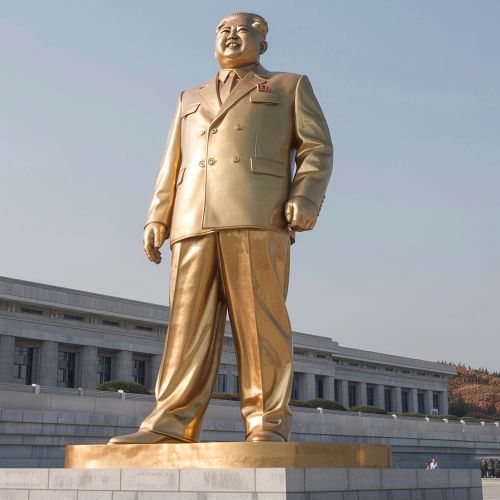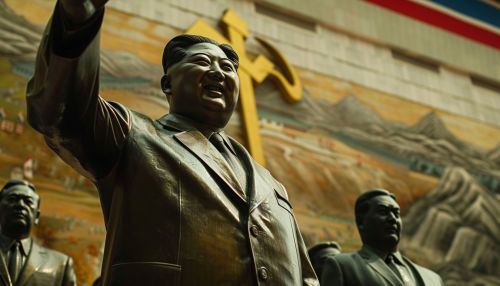Kim Il-sung
Early Life and Education
Kim Il-sung, born Kim Song-ju on April 15, 1912, in Mangyongdae, a suburb of Pyongyang, was the founding leader of North Korea. His early life was marked by the Japanese occupation of Korea, which began in 1910. Kim's family was actively involved in the anti-Japanese resistance, which significantly influenced his political ideology and future endeavors.
Kim attended a Chinese school in Manchuria, where his family had relocated to escape Japanese rule. His education was interrupted by his involvement in communist youth activities. By the age of 14, Kim had joined the Chinese Communist Youth League, and his involvement in revolutionary activities deepened.
Revolutionary Activities in Manchuria
In the 1930s, Kim Il-sung became a prominent figure in the anti-Japanese guerrilla movement in Manchuria. He joined the Northeast Anti-Japanese United Army, a communist-led resistance group, and quickly rose through the ranks due to his leadership skills and dedication. His guerrilla activities included sabotage, ambushes, and propaganda efforts aimed at undermining Japanese control.
During this period, Kim adopted the nom de guerre "Il-sung," which means "become the sun." His leadership and strategic acumen earned him recognition from both Chinese and Soviet communists. The Soviet Union provided crucial support to the guerrilla fighters, including Kim, who received military training and political education in the Soviet Far East.
Formation of the Workers' Party of Korea
After World War II and the defeat of Japan in 1945, Korea was liberated but divided along the 38th parallel, with the Soviet Union occupying the north and the United States occupying the south. Kim Il-sung returned to Korea with Soviet backing and quickly established himself as a leading figure in the northern zone.
In 1946, Kim played a key role in the formation of the Workers' Party of Korea (WPK), which became the ruling party of North Korea. The WPK was formed through the merger of several communist and socialist groups, and Kim's leadership was instrumental in consolidating these factions. He was appointed chairman of the party, a position that solidified his political power.
Establishment of the Democratic People's Republic of Korea
On September 9, 1948, the Democratic People's Republic of Korea (DPRK) was officially proclaimed, with Kim Il-sung as its first Premier. The establishment of the DPRK marked the beginning of Kim's efforts to build a socialist state based on the principles of Juche, a self-reliance ideology he developed.
Kim's government implemented sweeping land reforms, nationalized industries, and launched ambitious economic plans aimed at rapid industrialization. The state controlled all aspects of life, including the economy, education, and media. Kim's leadership style was characterized by a cult of personality, with extensive propaganda efforts portraying him as the "Great Leader."
The Korean War
The Korean War (1950-1953) was a pivotal event in Kim Il-sung's rule. On June 25, 1950, North Korean forces, under Kim's command, launched a surprise invasion of South Korea, aiming to reunify the peninsula under communist rule. The conflict quickly escalated into a full-scale war, drawing in the United States and United Nations forces on the side of South Korea, and China on the side of North Korea.
The war resulted in massive casualties and destruction but ended in a stalemate with the signing of an armistice on July 27, 1953. The Korean Peninsula remained divided along the Demilitarized Zone (DMZ), and the conflict solidified Kim's regime in the North. The war also reinforced Kim's reliance on military strength and his commitment to maintaining a heavily armed state.
Post-War Reconstruction and Economic Policies
After the Korean War, Kim Il-sung focused on rebuilding North Korea's shattered economy. The state adopted a centrally planned economic model, with an emphasis on heavy industry and self-sufficiency. The First Seven-Year Plan (1954-1961) aimed at rapid industrialization and collectivization of agriculture.
Kim's policies initially led to significant economic growth, with substantial improvements in infrastructure, education, and healthcare. However, the emphasis on heavy industry and military spending strained resources, leading to periodic economic difficulties. The Chollima Movement, launched in the late 1950s, was an attempt to boost productivity through mass mobilization and ideological campaigns.
Juche Ideology
One of Kim Il-sung's most enduring legacies is the development of the Juche ideology. Juche, often translated as "self-reliance," became the guiding principle of North Korea's political and economic policies. It emphasized national independence, self-sufficiency, and the central role of the leader in guiding the state.
Kim Il-sung articulated Juche in a series of speeches and writings, framing it as a uniquely Korean adaptation of Marxism-Leninism. Juche became the official state ideology, permeating all aspects of North Korean society. It justified the regime's isolationist policies and its emphasis on military strength and economic independence.
Cult of Personality
Kim Il-sung's rule was marked by an extensive cult of personality, which portrayed him as an infallible leader and the father of the nation. State propaganda glorified his revolutionary exploits, wisdom, and benevolence. Monuments, statues, and portraits of Kim were ubiquitous, and his birthday, known as the "Day of the Sun," became a major national holiday.
The cult of personality extended to Kim's family, particularly his son, Kim Jong-il, who was groomed as his successor. The regime used the cult to maintain political control and suppress dissent, with severe penalties for those who criticized or opposed the leadership.
Foreign Relations and Diplomacy
Kim Il-sung's foreign policy was characterized by a balancing act between the Soviet Union and China, North Korea's two main allies. He skillfully navigated the Sino-Soviet split, maintaining relations with both powers while asserting North Korea's independence.
Kim also sought to expand North Korea's diplomatic reach by establishing relations with newly independent countries in Asia, Africa, and Latin America. He promoted the Non-Aligned Movement and supported various revolutionary movements worldwide. Despite his efforts, North Korea remained relatively isolated on the international stage, particularly after the collapse of the Soviet Union in 1991.
Later Years and Legacy
In his later years, Kim Il-sung focused on ensuring a smooth succession for his son, Kim Jong-il. He continued to emphasize Juche and military strength, while also pursuing limited economic reforms to address ongoing challenges. Kim's health began to decline in the early 1990s, and he died of a heart attack on July 8, 1994.
Kim Il-sung's legacy is complex and controversial. He is revered in North Korea as the founding father and eternal president, with his body preserved in the Kumsusan Palace of the Sun. However, his rule is also associated with severe repression, human rights abuses, and economic hardship. The impact of his policies continues to shape North Korea's political and social landscape.


